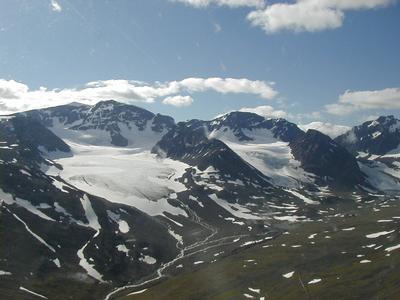12 July, 2001
The glacier that we are studying is called Storglaciaren. It is a rather unique glacier in that it is polythermal. Before I describe a polythermal glacier, I will first describe the temperature characteristics of glaciers in temperate zones and polar zones. A glacier in a polar zone such as Antarctica is categorized as a "cold" glacier. This means that the ice in the glacier is below the freezing point of water, and stays that way throughout the year. A typical temperature profile for a polar glacier might begin at just below freezing at the surface, cool to well below freezing within the first 5-10 meters, and then stabalize at a temperature corresponding to the mean annual air temperature for the remainder of the profile to near the bottom of the glacier. The glacier may then warm slightly near the bottom due to geothermal heating. During the summer the surface of a polar glacier may warm to melting temperatures, but within a short distance from the surface the temper!
!
ature of the glacier again becom
es the mean annual air temperature, which for a polar region is well below freezing.
A glacier in a temperate zone such as the Cascade Mountains, or the Wrangell-St. Elias Range of Alaska is categorized as a "warm" glacier. These glaciers are at their melting point throughout the year. A temperature profile for a "warm" glacier would correspond to zero degrees celsius at the surface, and stay at zero degrees to the bottom. Perhaps a thin skin of below zero ice might form on the surface of a temperate ("warm") glacier during the winter. But, these glaciers (such as Eliot Glacier on Mt. Hood or Winthrop Glacier on Mt. Rainier) typically receive thick blankets of snow that reach depths of 10-20 feet. This snow layer serves to insulate the surface of temperate glaciers from air temperatures that become quite cold in temperate mountainous regions.
Most glaciers of the world fall into these two thermal categories - either "cold" or "warm". Storglaciaren is different. It is an alpine glacier like the glaciers of the Cascades and Alaska, so based on the relative setting of Storglaciaren one would expect it to be similar in temperature to other alpine glaciers. However, it has a 20-30 meter thick layer of cold ice on the surface of the glacier. The temperature of this cold layer is below the freezing point of water. Hence, the top of Storglaciaren in a "cold" glacier. The remainder of the glacier below this ice is "warm", meaning that the ice is at its melting temperature. Perhaps someone might be able to offer a reason why the surface of Storglaciaren is so cold.......

Tarfala valley with Storglaciaren (left) and Isfall Glacier (right) nestled in the Kebnekaise massif. The Tarfala Station is situated in the lower right corner of the photograph.
Contact the TEA in the field at
.
If you cannot connect through your browser, copy the
TEA's e-mail address in the "To:" line of
your favorite e-mail package.
|
